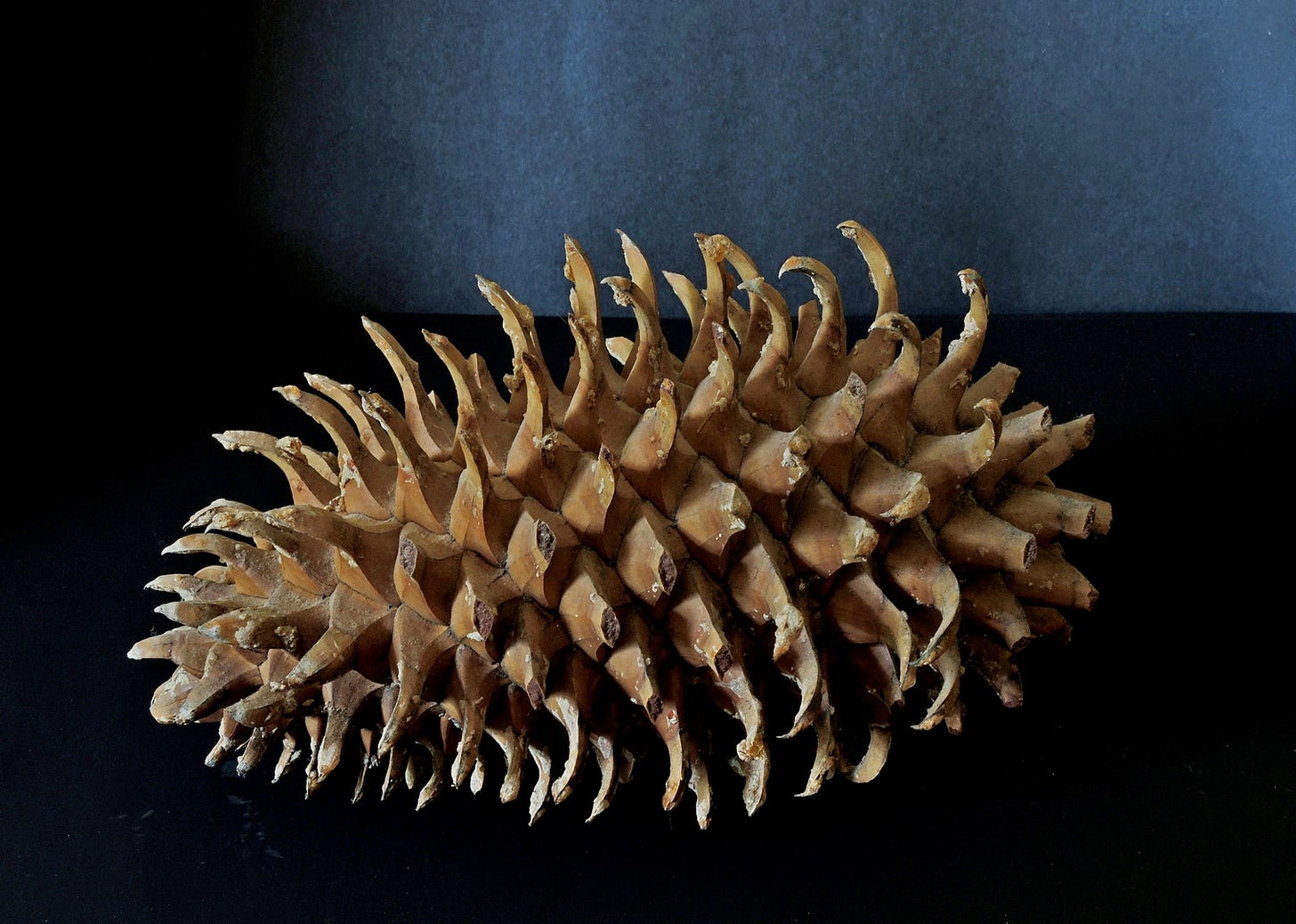There is something irresistible about pine cones, some emanation or radiation that makes people collect them, put them on their mantle, paint them gold to hang them on the Christmas tree, skewer them in flower arrangements, row them up along the front walk and stuff them into a bag next to the fireplace, ready to serve as kindling. Only the last really makes sense. Of course, there are many species of pines in the northern hemisphere, and their cones, although based on the same fundamental plan, are quite variable. The small and unassuming pinyon pine rewards the collector with edible seeds, something the half-meter long cone of the sugar pine does not do. Here in the South, we have the largish cones of longleaf pine, the modest cones of slash, short-leaf, sand, pond and loblolly pine, and the tiny, prolific cones of the spruce pine. Sand pines keep their cones closed and their seeds to themselves until they burn in a catastrophic fire, whereupon they shed a dense rain of seeds from their charcoaled branches and roasted cones, starting the forest anew.
Even people who are not from Texas are fascinated by extremes--- the largest, the smallest, the heaviest, the longest or otherwise the mostest. Two Californian pines, the digger pine of the Sierra Nevada foothills and the Coulter pine of the southern Californian mountains, vie (and tie) for the heaviest, densest, most whopping cone. But where the end of each cone-scale of the digger pine bears a short thorn, that of the Coulter pine bears a sharp tusk long enough to make a male warthog proud. You wonder, what is the Coulter pine trying to defend against? It is hard to imagine an animal capable of noshing on these scary cones. Perhaps an extinct ground sloth? To grab a cone of the Coulter pine is to invite manual laceration of the most serious kind, complicated by the gobs of pitch that usually festoon the cone as well. Something this dangerous and mean has appeal even outside the South, where venomous, dangerous, mean things are revered.
Coulter pines grow at mid-elevation in the mountains on the road between San Diego and the Anza-Borrego Desert. Our friends twist their heads around as we pass trees with these colossal cones, asking timidly if we could collect a couple on the way back. Upon our return, we come equipped, for there are two inherent problems with this project: first, the aforementioned laceration risk requires heavy leather gloves or swaddling with a rag; and second, the pines don't drop their cones to be conveniently picked up off the ground. No, firmly anchored to stout branches that are seemingly always just out of reach, they are waiting for a fire, and they remain tight-lipped until it arrives. So, we came prepared with a rope weighted with a hunk of iron, to be tossed over a cone-bearing branch so we can twist the cone off after covering it with a thick rag. As the cones resist with all their might, our efforts became a sort of comedy, and we ended up sticky and bleeding by the time we wrested a couple free. Heavy as rocks in the hand, they stand proud on their tusks on the floor of the trunk. Doesn't everybody transport rag-wrapped Coulter pinecones in their carry-on luggage? They do when they travel with us.
Our friends got the cones home to Tallahassee without further mishap, but the cones remained tight and mum, waiting for fire before agreeing to open. To accommodate them, our friends put the cones in an oven. As the temperature topped 300 degrees, the cones suddenly popped open. Our friends are nice people, so I expect they didn't say "I fooled you, sucker!" But I know for sure they didn't spray them gold before putting them on their mantle. No, they revere them as the wonderful natural objects that they are--- beautiful, dangerous, and mean.




in searching to see if the opening of the cone was recorded somewhere I found this timelapse - other readers, enjoy! https://youtu.be/3vNaJUIh0Po
years ago, when I was working on my guidebook to the national parks of Canada, I was introduced to the Limber Pine (Pinus flexilis) as part of a Parks interpretive walk. I still remember him showing us how it could even be gently knotted, with maybe one loop. this would have been in Alberta, maybe Banff. then when I went to similar habitats, I would look for them and do a little "bend test". really stayed with me. and the piney woods of Florida around Gainesville, where the trees was gashed in that chevron cut, for collecting sap for turpentine. My father told me a wonderful story of watching the gathering, not unlike maple syrup processes. with the talleyman going around on a buckboard, with mule, to take the buckets from each worker. this would have been the long-needle pine?